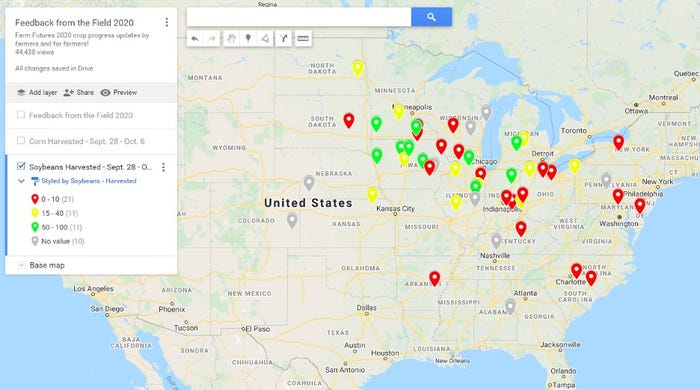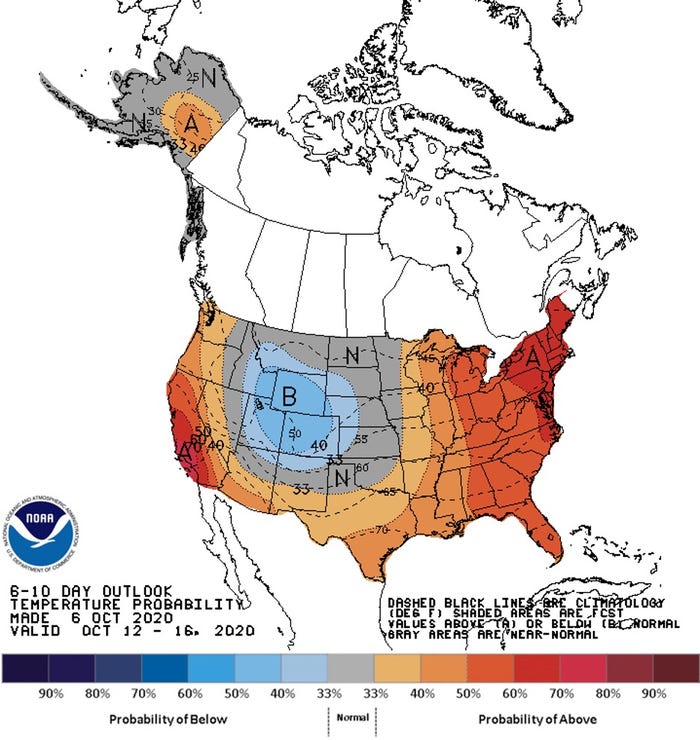
Want to see your harvest progress stacks up against other growers in the country? Click here to share your crop updates via a short survey. The map is updated daily to showcase harvest progress across the country. Thank you!
U.S. soy growers surged ahead with harvest progress last week thanks to dry and warm weather which favored harvest conditions. More plants reached maturity through the week ending October 4, with 85% of plants dropping leaves, up 11% from the week prior and 3% higher than the five-year average.
As the crop approaches final maturity, harvest progress surged to 38% complete for the week, up 18% from a week ago and 10% ahead of the five-year average for the same time period. Crop ratings stabilized at 64% good to excellent for the second week in a row.

Yield reports from Feedback from the Field survey respondents have been variable, at best, over the past week. An Ohio farmer summed it up best, saying “Some fields are very poor. Some fields are average.” An Indiana farmer estimated that “[yield] potential deteriorated 10-20 bpa in the last several weeks prior to harvest.”
A Michigan grower echoed these sentiments as combines rolled through the area. “Soybeans on the northern half of our area on lighter ground were 10-20% below average,” the Wolverine State grower reported. “As we move south where there was slightly more rain and heavier ground, more like 5% -10% over average. We have averaged 59 bpa on roughly 2,500 acres of soybeans for the last 5 years. We will probably finish around 57 bpa this year.”
Further to the west, farmers are seeing just as much damage. “[Yields are] 20 bpa off average,” lamented a Northern Illinois farmer. “Lots of pods, but not as full,” reported an Eastern Iowa grower. A Central Illinois farmer found yields to be “down 20%.”
But not all farmers reported yields in complete disrepair. “50 to 65 bpa so far,” a Northeastern Ohio farmer stated. Another Northern Illinois grower “made 95% of APH [yields].” A second Eastern Iowa reader got lucky with minor yield losses amid wind damage. “I am fortunate to say that beans were off about 7 bpa from last year,” said the farmer. “The beans were very short this year.”
Corn harvest continues to lag
After two weeks of lagging behind the five-year average for harvest pace, corn combining progress overtook the historical metric in yesterday’s Crop Progress report due to favorable harvest weather across the Corn Belt last week. As large portions of the crop matured last week, with 87% of the crop matured as of Sunday, farmers were able to make strong grains in the fields.
A Michigan Farm Futures reader noted the dry weather late this summer helped speed up the maturation process. “Corn will be drier this year than it has been for several fall [seasons],” the grower reported. “August was hot and crops on light ground didn't do well. Crops on heavy ground appear to be in great condition.”
As of October 4, 25% of the crop was harvested, up 10% from a week ago and 1% of the five-year average for the same time period. But even though the total was up from historical averages, yesterday’s mark still came in below the average trade estimate of 26%. The warm and dry weather favored crop ratings, which improved 1% on the week to 62% good to excellent.
Yields in Iowa continue to suffer due to damages from the August 10 derecho wind storms. “[Corn on corn acreage] is 75 bpa below average.” A Northern Iowa grower echoed the sentiment, noting “yields are lower than expected.” Central Illinois growers also struggled with wind and heat damage, with one farmer forecasting yields to be “down 50 bpa from expectations.”
But just a little farther to the South in Kentucky, timely rains supported strong yield projections. “Yields have been from 175-230 bushels per acre depending on rain at each field,” reported a local farmer. “Moisture has been running from 19%-26% on corn and has not dropped much lately. All in all, a good start for us where 175 bpa average is a good year.”
Wheat planting stumbles in the Plains
Rapid corn and soybean harvest progress will continue to help winter wheat planting to advance ahead of average expectations. As of October 4, 52% of U.S. winter wheat had been planted, up 17% from the week before and 5% above the five-year average. About 24% of the planted crop was emerged as of Sunday, up from 10% last week and ahead of the five-year average of 21%.
Markets are already jittery with the prospect of reduced 2021 yields due to the drought conditions on the Plains as well as in the Black Sea – the world’s top wheat-producing and exporting region. Wheat planting progress will be closely monitored in the coming weeks as dry soil moisture conditions threaten yield potential for next year’s hard red winter wheat crop, particularly in the Southern Plains.
One farmer in Southeastern Colorado succumbed to the dry weather and “gave up planting due to the severe drought.” A Nebraska farmer continues to delay planting stating, “we are waiting on rain to finish planting.”
Midwestern farmers looking to plant soft red winter wheat are finding better luck with soil moisture levels. “Soil conditions were excellent for wheat planting,” reported an Ohio grower who finished winter wheat planting last week. “Got 1.2 inches rain right after planting.” A Michigan Farm Futures reader echoed those comments, noting “excellent wheat planting conditions and most of it is up.”
Many farmers continue to wait for fields to dry and corn and soybean harvests to finish to pick up planting progress. “Too wet to get in the fields,” a Wisconsin wheat grower lamented. “[It’s] going to be very difficult to get beans off in time to plant winter wheat in this area. Deadline for crop insurance is October 6.”
Chances for rain delays?
While dry weather is likely to persist late next week, the Northern Plains and Eastern Corn Belt will could see more precipitation early next week. NOAA’s 6 to 10-day outlook shows a 33% - 40% chance of above average rainfall in the region starting next Monday. But it will be short-lived, as below average chances of rain dominate the forecast late in the week, minimizing the potential for possible rain delays during harvest.

The West and Central to Southern Plains will remain dry during the same time period, with a 33% - 40% chance of below average rainfall in the region between October 12 – 16. This will continue to hinder planting progress for the hard red winter wheat crop in the region.
Temperatures will continue to trend warm, with chances for above average temperatures early in the week ranging from 33% - 50% across the Eastern Corn Belt. Cooler temperatures will settle into the Midwest by the weekend.

Follow along with the season:
Feedback from the Field Roundup: Week Ending September 20, 2020 - Corn conditions improve as harvest ramps up
Feedback from the Field Roundup: Week Ending September 13, 2020 - Harvest in sight across the Midwest and Plains.
Feedback from the Field: Week Ending September 6, 2020 - Soybeans cave to heat stress and low soil moisture
Feedback from the Field Roundup - Week ending August 30 - Corn, soybean ratings continue to slide lower.
Feedback from the Field Roundup – Week ending Aug. 23, 2020 - A closer look at derecho crop damage sends corn ratings tumbling.
Feedback from the Field Roundup: Week Ending August 9, 2020 - Dry conditions expected to be exacerbated by yesterday’s derecho winds.
Feedback from the Field Roundup: Week ending August 2, 2020 - Wheat harvest rolls on in the Northern U.S.
Feedback from the Field Roundup – Week ending July 26, 2020 - Improved corn conditions offset drought, wind damage.
Feedback from the Field – Week ending July 19, 2020 - Crops withstand the heat while pastures and rangeland suffer lowest ratings since 2012.
Feedback from the Field: July 7, 2020 - Crops stand up to hot weather – for now.
Feedback from the Field: June 30, 2020 - Despite strong ratings, the corn crop may face challenges during silking process.
Feedback From The Field: June 23, 2020 - Readers report solid corn and soybean crop quality so far this year.
About the Author(s)
You May Also Like






